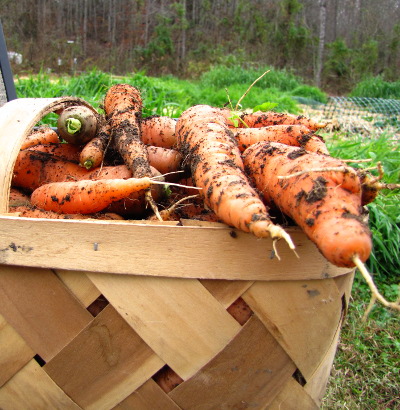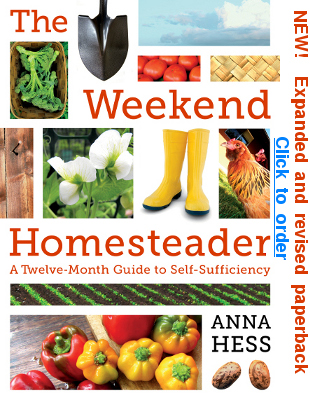
Vegetables for early spring

Even under quick hoops,
you won't want to plant frost-sensitive
vegetables like tomatoes and cucumbers anytime soon. However,
there is still a wide selection of crops to choose from for your spring
garden. I've highlighted the easiest ones in the chart below.
| Vegetable |
Start from: |
Notes |
| Beets |
Seeds |
Beet seeds can sometimes be
difficult to germinate. As with other root crops, beets need
loose, loamy soil. |
| Broccoli |
Transplants |
The more advanced gardener can
start her own seedlings either inside or in a quick hoop.
Otherwise, buy sets from the local feed store when night temperatures
have risen into the high 20s to low 30s Fahrenheit. |
| Brussels sprouts |
Transplants | The more advanced gardener can start her own seedlings either inside or in a quick hoop. Otherwise, buy sets from the local feed store when night temperatures have risen into the high 20s to low 30s Fahrenheit. |
| Cabbage |
Transplants | The more advanced gardener can start her own seedlings either inside or in a quick hoop. Otherwise, buy sets from the local feed store when night temperatures have risen into the high 20s to low 30s Fahrenheit. |
| Carrots |
Seeds |
Well-drained, loamy soil is
mandatory. Carrots are slow-growers, so weed carefully to give
the seedlings breathing room. |
| Cauliflower |
Transplants | The more advanced gardener can start her own seedlings either inside or in a quick hoop. Otherwise, buy sets from the local feed store when night temperatures have risen into the high 20s to low 30s Fahrenheit. |
| Collards |
Seeds |
Spring
greens are some of the easiest vegetables to grow. In addition to
collards, spinach, and Swiss chard, consider trying some Asian greens
for variety. |
| Leeks |
Seeds |
Leeks take a long time to grow, so I generally prefer the perennial Egyptian onions instead. As with other root crops, leeks need loose, loamy soil. |
| Lettuce |
Seeds |
Leaf
lettuce is my earliest harvest of the year because I always plant it
under quick hoops. You can cut leaves within a month of
planting, but be sure to seed a second bed as soon as you start eating
the first --- lettuce becomes bitter within a few weeks of first
harvest. |
| Onions |
Seeds, sets, or transplants. |
Getting your onions to germinate
out in the cold can be a bit tricky, so you may choose to start them
inside or under quick hoops to ensure they have time to grow before
summer heat stunts them. Select a variety
appropriate for your day length (short day in the south and long day in
the north.) Many gardeners simplify planting by buying sets (tiny
bulbs) from the local feed store, but onions grown from sets usually
don't store well. |
| Parsley |
Seeds |
Parsley is grown very similarly
to carrots, but you pick the leaves a few at a time for the next year
rather than digging up the root. |
| Peas |
Seeds |
Soak
your seeds overnight before planting to ensure they sprout
quickly. Erect a trellis for them to grow on. |
| Potatoes |
Cut
up pieces of potato, each with two eyes |
Hill
up your potatoes by adding soil or dirt extending a few inches up the
growing
stem once the plant is about eight inches tall. This prevents the
new tubers from being exposed to sunlight and turning green. If
you're planting early into cold soil, consider cutting your seed
potatoes a few weeks in advance and laying them out in a bright spot so
they'll presprout. |
| Radish |
Seeds |
Some
gardeners plant radish seeds in their carrot rows. The radishes
come up quickly and mature before they compete with the
slower-growing carrots. |
| Spinach |
Seeds |
I find that spinach plants
usually bolt in the spring, so I generally focus on other varieties of
leafy greens. |
| Swiss
chard |
Seeds |
Swiss
chard seeds can sometimes
be difficult to germinate, but otherwise Swiss chard is perhaps the
easiest green to grow and will keep producing all summer. |
| Turnips |
Seeds |
Like other root crops, turnips
prefer loamy, well-drained soil. |
 The raw beginner should start out with collards, lettuce, peas,
potatoes, radishes, and Swiss chard. Second year gardeners might
add broccoli, carrots, and parsley. But ignore my advice if you
love beets and hate lettuce --- plant what you like to eat!
The raw beginner should start out with collards, lettuce, peas,
potatoes, radishes, and Swiss chard. Second year gardeners might
add broccoli, carrots, and parsley. But ignore my advice if you
love beets and hate lettuce --- plant what you like to eat!This week's lunchtime series is excerpted from Weekend Homesteader: March. I saved some of my favorite projects for last, so I hope you'll splurge 99 cents to read about growing edible mushrooms, composting, and attracting native pollinators. And, of course, the ebook has the full spring planting chapter in case you just can't wait to read each installment at noon this week.
| This post is part of our Spring Planting lunchtime series.
Read all of the entries: |
Want more in-depth information? Browse through our books.
Or explore more posts by date or by subject.
About us: Anna Hess and Mark Hamilton spent over a decade living self-sufficiently in the mountains of Virginia before moving north to start over from scratch in the foothills of Ohio. They've experimented with permaculture, no-till gardening, trailersteading, home-based microbusinesses and much more, writing about their adventures in both blogs and books.
Want to be notified when new comments are posted on this page? Click on the RSS button after you add a comment to subscribe to the comment feed, or simply check the box beside "email replies to me" while writing your comment.
RSS
great web site !!!
As is above; I love ur website !!! it's so eqasy to follow; Yeah !!! i'M AN OLD MAN, WHO AM SLOW AND SHAKY ... THANK YU !!!
Comment by
DENNIS BARES
— Wed Sep 19 21:26:36 2012
- Remove comment
Website
Dennis --- Thanks for your kind words. I'm glad you're enjoying our site. 

Comment by
anna
— Thu Sep 20 15:02:21 2012
- Remove comment
Add a comment
